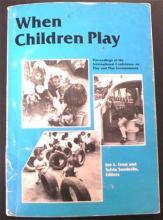
When Children Play, Proceedings of the International Conference on Play and Play Environments is a compilation of papers given at the International Conference on Play and Play Environments held at the University of Texas at Austin in 1983. The conference was sponsored by 14 professional organizations and drew more than 500 attendees. Of the 120 scholarly papers on play that were presented, 72 papers were submitted for publication. Those papers were then winnowed down through a “blind” review process in which each paper was read by three colleagues of doctoral status.1
Joe Frost and Sylvia Sunderlin, as co-editors, organized the resulting 47 papers in categories of play and playgrounds: Understanding Play; Play, Learning and Development; How Children Use Playgrounds; Trends in Designing and Developing Playgrounds; Indoor Play Environments and Play Materials; The Role of Adults in Promoting Play; and Play as an Assessment Tool.
To lay the foundation of the book, Dr. Frost characterized play as “the child's art form, the vehicle for creative expression, the primary avenue to learning and development, a source of joy and contentment.”2 He further defined that “All play proceeds from, and has its existence within, a play environment designated physically or symbolically.”3 With play and play environments outlined, the chosen scholars' papers were presented, demonstrating the diversity and broad scope of play research at that time.
The “Understanding Play” section includes papers about the history of outdoor play, the status of play research, and Children's Views of Play.4 This was followed by “Play, Learning and Development,” which included research results concerning play and children's problem solving development as well as a study of play and social development in Taiwan. The editors summarized this section with the conclusion:
“The hypothesis that play is a primary medium for learning and development in young children has substantial foundations in research and theoretical literature. There are, however, many unanswered questions about the nature and extent of play's influence on cognitive and social development.”5
The following three sections involve research on play environments. “How Children Use Playgrounds” ranges from the effect of different types of playgrounds on children's development to studies of what play equipment children choose during free play. “Trends in Designing and Developing Playgrounds” gives an historical background to playgrounds, explores the adventure playgrounds of Denmark through Jens Pedersen's guidance, and covers newer trends in play spaces such as the use of music and plants.
“Indoor Play Environments and Play Materials” completes the discussion of play spaces with a look at the different effects of dense or more open areas on children's play and the effect of video game play on social behaviors. In the latter, a study by Steven B. Silvern, Peter A. Williamson, and Terry A. Countermine found that children's aggression was higher before playing competitive video games leading them to conclude that video game play “may have a cathartic effect.”6
“The Role of Adults in Promoting Play” section covers studies of the effects of play training for teachers, including how children respond to play facilitation by adults. The section concludes with expanding beyond child care and educational environments to the home play environment. In Strengthening Family Ties in Play Settings, practical ideas are given to “support children's natural propensity for play and nurture family ties in play settings.”7
The final section, “Play as an Assessment Tool,” discusses motivational competence, pretend play, and imaginativeness. In the final summary of When Children Play, the editors declare:
“These and related studies show that we are on the threshold of exciting new knowledge about children's play. As the new researchers highlighted in this volume enter the field, alongside their colleagues with similar interests, our understanding of the value of play in human development will continue to grow.”8
- 1. Frost, Joe L., and Sylvia Sunderlin, eds. When Children Play, Proceedings of the International Conference on Play and Play Environments. Wheaton: Association for Childhood Education International, 1985. p. vii.
- 2. Op.cit., Frost and Sunderlin. p. ix.
- 3. Op.cit., Frost and Sunderlin. p. x.
- 4. Note: Children's Views of Play was authored by Margaret Garza, Sandy Briley and Stuart Reifel.
- 5. Op.cit., Frost and Sunderlin. p. 43.
- 6. Op.cit., Frost and Sunderlin. p. 254.
- 7. Op.cit., Frost and Sunderlin. p. 284.
- 8. Op.cit., Frost and Sunderlin. p. 337.

